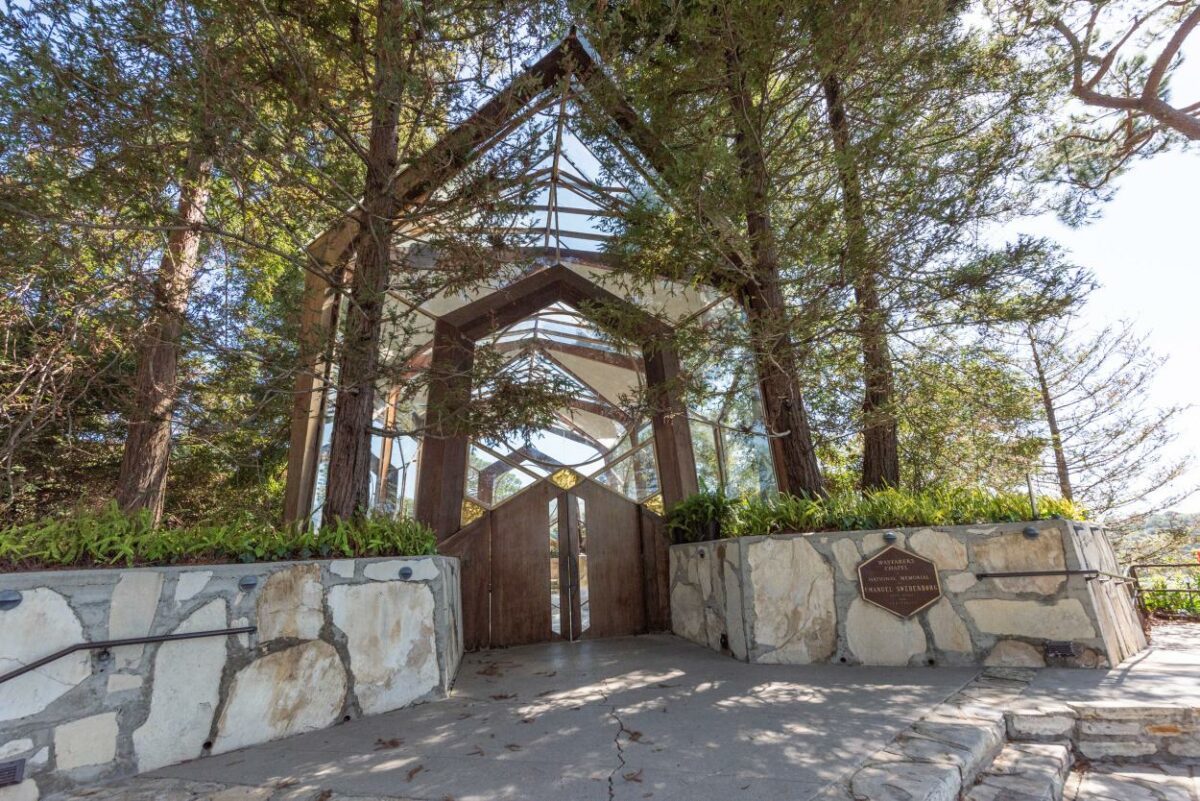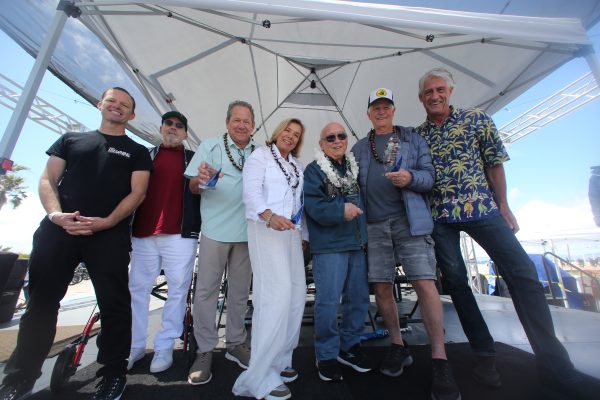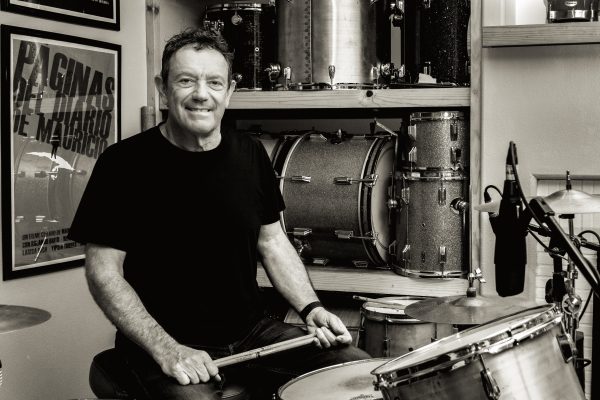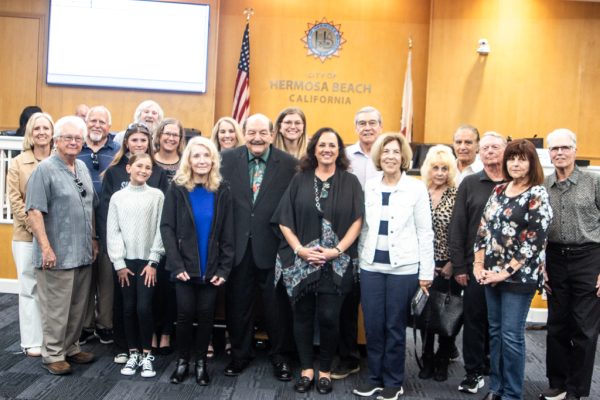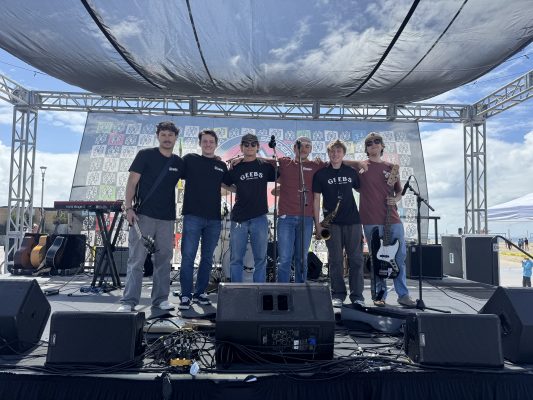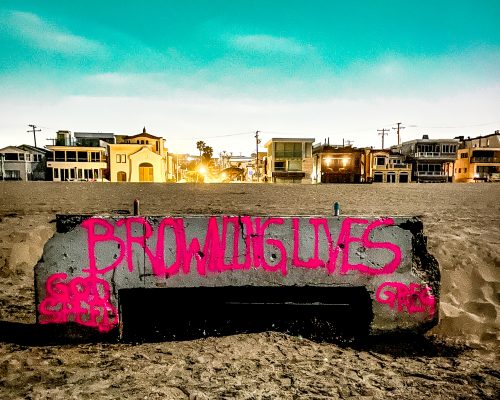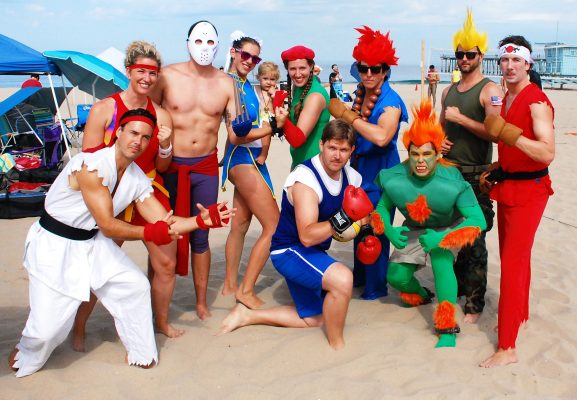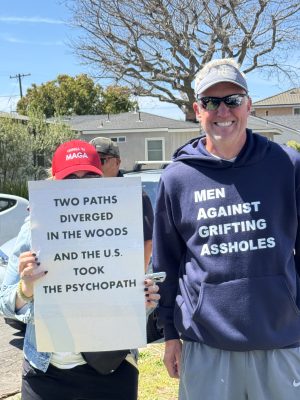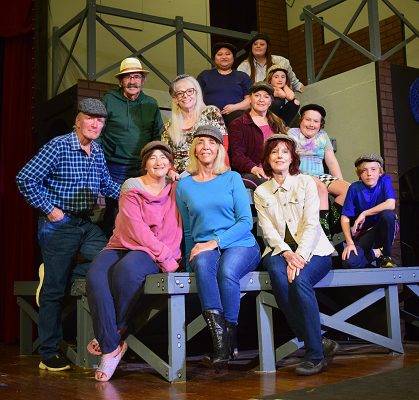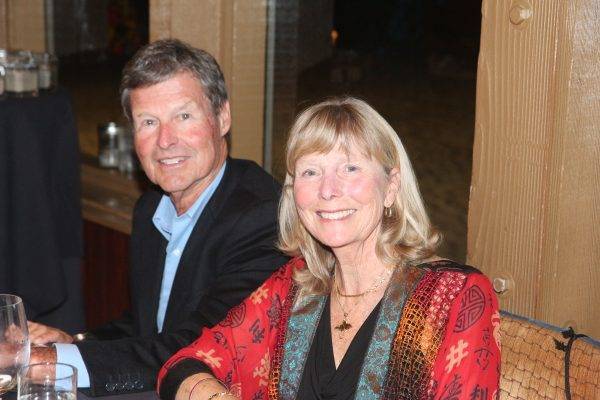by Mark McDermott
The telltale cracks began appearing last July. They began in the asphalt parking lot, but soon spread.
Reverend Dan Burchett, the executive director of the Wayfarers Chapel, quickly came to understand the magnitude of what was unfolding. He’d begun as an officiant at the chapel in September 2000, and knew all too well the site is adjacent to the Portuguese Bend landslide area, which is among the most well-known geologic “slope failures” in the region, if not the nation.
“It’s an eight-tenths of a mile geological site that is in every college textbook you can find as a famous land movement site,” Burchett said.
Burchett and everyone else involved with the chapel had long been accustomed to living next to a landslide. They had thus far been spared catastrophe. The southernmost border of the property, closest to the Portuguese Bend slide area, was most impacted. Decades ago, they’d lost the Wayfarers Chapel visitors center due to land movement. But the chapel, now 73 years old, had remained unharmed.
“We were far enough removed from it so that it was just very slow movement,” Burchett said. “It did not have an impact on the chapel itself. Every year, during our January work week, we would address the needs of the chapel, and periodically we would see cracks. We would kind of deal with those cracks as best you can, but they were very limited.”
An asphalt repair crew redid the parking lot. But soon, more cracks appeared, worse than the initial wave of damage.
“Six weeks after they did the work, we stopped doing anything [to address the damage] because there was no reason to repair,” Burchett said. “The continuing asphalt upheaval was far worse than it was originally, due to not being able to secure the grounds.”
It was then that Burchett knew this was different from anything that had occurred previously. The landslide had reached the Wayfarer Chapel’s grounds, and it was not done. The Chapel’s leadership, which includes a board of directors, Burchett, and Reverend David Brown, the chapel’s current officiant, was forced to limit public access to special events, such as weddings. Initially the hope was that the damage could somehow be limited, but as the months wore on, it continued to worsen. Cracks began to appear in the chapel’s foundation and in its stone walkways. A retaining wall outside bulged until it split open. Eventually, window panes started to fracture.
The eerie description written by Dr. Robert Douglas in an academic journal a decade ago became newly resonant. “‘The Creepy Landslides of Portuguese Bend’ may sound like the title of a horror movie,” wrote Douglas, who was a Rancho Palos Verdes resident. “[But] it describes a real phenomenon that exists in nature and confronts people and institutions.”
The Wayfarers Chapel is arguably the most cherished institution on the Palos Verdes Peninsula, and certainly its most iconic. The glass chapel was designed by architect Lloyd Wright, the son of Frank Lloyd Wright, and christened on Mother’s Day in 1951. It was built as a memorial to Emanuel Swedenborg, an 18th century Swedish scientist and philosopher who in the second half of his life became a hugely influential Christian theologian and nature mystic whose work influenced generations of some of the worlds greatest poets, spiritual seekers, and thinkers, including William Blake and Ralph Waldo Emerson. Several of the early founders of the Peninsula, including members of the Vanderlip family, who donated the land upon which the chapel was built, were part of a spiritual denomination historically known as the Swedenborgian Church.
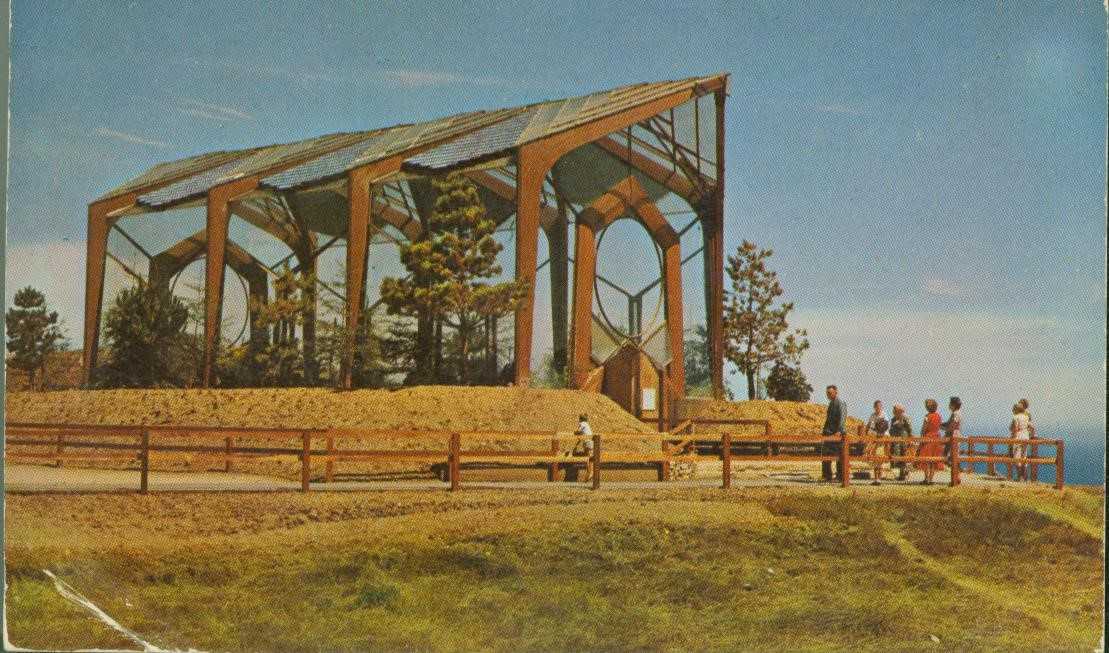
The architecture and history of the Wayfarers Chapel is so significant that in December, after a five year review process, the United States Secretary of the Interior named the Wayfarers Chapel a National Historic Landmark. It joined such historically revered structures as the Eames House in Pacific Palisades and Watts Towers as among the few sites in the Los Angeles area to receive this designation.
As David Brown told the LA Times when the chapel’s landmark status was announced on December 13, its architecture achieves the unusual feat of expressing spiritual reverence for nature through the simple use of glass and redwood beams. The stone pines and small redwood grove that surround it don’t feel separate from the structure. Rather, to walk into the 100-seat chapel is to be somehow embosomed in the trees.
“Militant atheists who don’t believe in anything feel something in our chapel,” Brown said. “The chapel is a Mid Century architectural gem. People may have never read our theology, but by simply walking into Wayfarers Chapel, they are living out a core part of our theology. The natural world corresponds with the spiritual…The chapel makes it easy to find the divine in nature.”
But over the course of the next two months, nature kept moving. The landslide was moving the fastest it had moved since Palos Verdes was settled more than a century ago, and since its modern day awakening when land movement began occurring in the 1950s. Some areas had moved eight feet in less than half a year, and all areas were picking up speed.
“It’s moved more in the last two months than it did in the prior three months,” City geologist Mike Phipps told the Rancho Palos Verdes City Council in March. “We’re talking about movements now on the order of two-and-a-half to three feet in the last couple of months in Portuguese Bend, one-and-a-half to three-and-a-half feet in Abalone Cove.”
“The takeaway,” Phipps said, “is that the entire landslide is accelerating, and continues to accelerate.”
The cause was rain. Since October of 2022, the Palos Verdes Peninsula had experienced unusually high rainfall, which geologists had determined was the key factor behind the accelerated land movement. Last winter, things got even more wet. The area received the second highest amount of rainfall in its recorded history, including 11 inches of rain in February alone.
Things worsened at the Wayfarers Chapel. Some areas in the property moved 1.5 feet in December and January. The rains kept coming and the land kept moving. In mid-February, the Chapel was closed to visitors. A dozen windows had broken. The chapel was in danger of structurally failing.
The landslide had not only accelerated but expanded. The Portuguese Bend landslide complex has four separate areas – Portuguese Bend, Abalone Cove, Klondike Canyon, and the Flying Triangle landslide areas – in what is collectively known by geologists as the Greater Portuguese Bend Landslide Complex. After this winter, the landslide area grew to the size of what geologists call the Ancient Portuguese Bend Landslide Complex. The landslide that most people knew had begun moving in 1956, spurred by the construction that occurred when LA County extended Crenshaw Boulevard. Over seven decades, its four areas encompassed roughly 380 acres.
At the March 19 RPV council meeting, Phipps held up a map that showed a green line drawn outside the known landslide area, bulging out to include the area of Wayfarers Chapel, as well as other areas.
“What you see in the green line he’s mapping out now is how areas that haven’t moved in 70 years are now moving,” City Manager Ara Mihranian told the council. “It’s growing not only to the north, but to the east and west. It’s almost lining up with the boundary lines of the ancient landslide complex.”
The landslide area was now 675 acres.
“It’s big, and it’s deep,” Phipps said. “It’s a 150-foot deep, one square mile area of land that is slowly moving towards the ocean.”
Phipps said that parts of Palos Verdes Drive had moved six feet horizontally and a foot vertically in the previous five months. Councilperson David Bradley asked if the entire road might fail.
“Is PV Drive safe right now?” he asked. “And is there a failure mechanism that could see PV Drive South move catastrophically?”
“I don’t see the potential for catastrophic movement but we are seeing an unprecedented rate of movement right now,” Phipps said. “And so what we’re experiencing is conditions rapidly changing. Whereas before you might have been able to maintain it over a period of months, now, it’s days, or weeks.”
“We used to re-pave it once a year,” Bradley said. “Now it’s like painting the Golden Gate Bridge. You start on one end, repave, and get to the other end, start on that end and go back again. I mean, it’s dramatic.”
“We’re talking about moving rates that are close to half inch per day right now,” Phipps said. “We’ve been watching the behavior of this landscape for a long, long time. Decades. And yes, it’s moving quicker than it ever has….But I don’t see the potential for catastrophic failure. I think it’s marginally safe at best right now.And then things need to be done.”
The council allocated $8 million in “de-watering” mitigation efforts that included installation of two emergency hydraugers, horizontal wells that extract water, and filling several of the fissures that have emerged. The City was hopeful that these measures could significantly arrest land movement.
But nothing could be done to save Wayfarers Chapel. Its impossibly fragile structure was part of what made the Chapel an architectural marvel. While mitigation efforts can slow land movement, this would not be not enough to keep the Chapel safe. By May, the ground underneath the chapel was moving an average of an inch per day.
“We cannot stop the landslide,” Mayor John Cruikshank said at a May 13 press conference near the chapel.
The conference was held to announce that Wayfarers Chapel would be disassembled. Due to its landmark status, approval to do so needed to be obtained from the National Park Service. That approval was granted a week earlier. Now the task at hand, the mayor said, is to find the chapel a new home.
“We are committed to working with Wayfarers to ensure the chapel can quickly be rebuilt in a geologically safe location somewhere within our city,” Cruikshank said. “If possible.”
“This is a devastating time right now for Wayfarers and for the City,” said Mihranian, the city manager. “It’s a very sad day for us today.”
And so almost 73 years to the day that Wayfarers Chapel opened its doors, on Mother’s Day in 1951, it not only closed, but began its process of departure.
Burchett, though saddened by what he described as a “looming tragedy” affecting not only the chapel but the surrounding community, also took sustenance from what he saw as the spiritual lesson offered by the chapel’s fate.
“It’s a parable about life, and the impermanence of life, the fact that this chapel has stood erect for 73 years, and she is experiencing a death,” Burchett said in an interview last month. “And in one very real way, it’s a parable of what our lives are, the impermanence of materiality, the inevitability of decline and death, and what I’m calling a miraculous resurrection that we are working hard to secure as we move forward looking for property and in the deconstruction process that we are pursuing with determination and speed.”
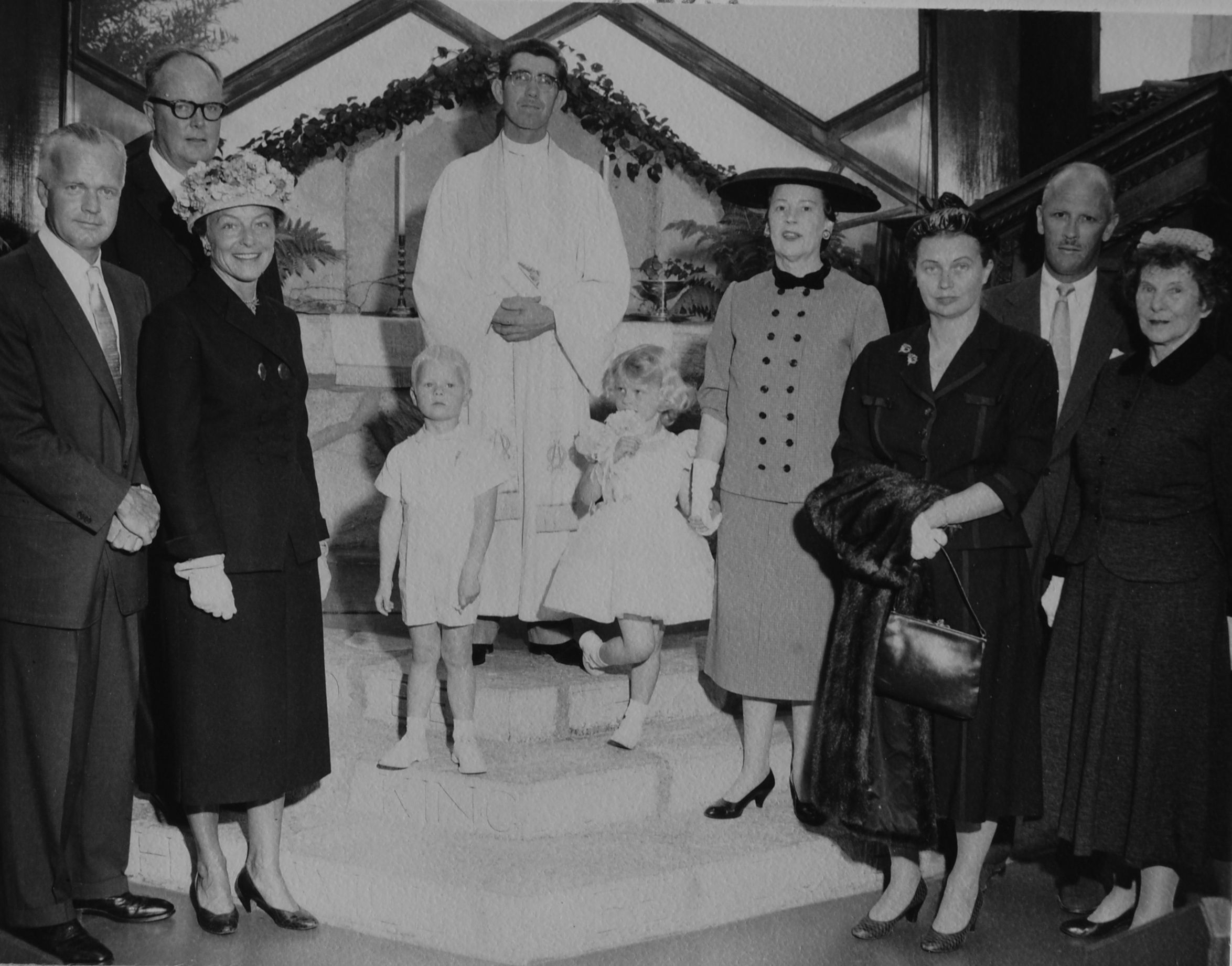
Kelvin Vanderlip, Viv McCracken (Henrik’s godmother), Jonny Green (Katrina’s godfather), Henrik Vanderlip, Katrina Vanderlip, Mary Frankl, Elin Vanderlip (Katrina and Henrik’s mother) Sandy Saunderson and Narcissa Vanderlip. Photo courtesy of Katrina Vanderlip
Wayfaring history
The word wayfarer originates in the Middle Ages and refers to a traveler, especially on foot, who is passing through. The conception of the Wayfarers Chapel was as a place for people passing by on the Pacific Coast to stop for a moment of spiritual respite.
“It was to be a wayfarer’s chapel,” said Katrina Vanderlip, the granddaughter of Narcissa Vanderlip, who was a dedicated member of the Swedenborgian Church and donated the land the chapel is on. “In other words, somebody driving up or down the coast could stop there and commune with God.”
The Vanderlips originally came to Palos Verdes as a real estate proposition but stayed because of the power of the land.
Frank Vanderlip, who was born in 1864, was an Illinois farm boy and factory worker who attended the University of Illinois for one year and then became the editor of a newspaper at age 21. He attracted the attention of a prominent economist, and through a circuitous route that included working as an investigator for stock investors and working as a finance reporter for the Chicago Tribune, Vanderlip became Assistant Treasurer Secretary under President William McKinley. He was in charge of heading a $200 million bond issue to fund the Spanish-American War, and was subsequently recruited to the private sector. By 1909, he was the president of the National City Bank of New York, then the largest bank in the country. He was hugely influential, and is credited as one of the founders of the Federal Reserve.
Vanderlip headed a group that bought the 26,000 acres of the Palos Verdes Peninsula in 1913. He came to vacation in PV the following year while recovering from an illness, and was so astonished by the beauty of the area that he began to take a personal interest in its development, bringing in the famous Olmsted Brothers to oversee its landscaping plan. The onset of WWI – during which Vanderlip and his wife Narcissa traveled the nation by train selling war bonds – delayed his plans for Palos Verdes, but afterward, in 1924, they built a home, Villa Narcissa, and began to plant roots on the peninsula.
The Vanderlips were among the most progressive elites of their time. They founded the nation’s first Montessori School in their native New York, and were a part of the Swedenborgian Church, a small but unusually influential Christian denomination and theology whose followers and admirers included Helen Keller, William Butler Yeats, Robert Frost, Calvin Coolidge, Franklin Roosevelt, John Muir, Carl Jung, and Johnny Appleseed.
Swedenborg himself is one of the most fascinating and surprisingly little known figures from the Enlightenment. He was born in Sweden in 1688. He was the first scientist to describe what would later be called a neuron, and the first to write about the different cortical functions within the human brain. He was also a geologist who correctly identified the bones of a whale found on a Swedish mountaintop that people at the time had thought was the remains of a race of giants (he is certainly the only scientist-mystic who has a whale named after him, Balaena swedenborgii, a bowhead whale). He was also a mathematician, chemist, metallurgist, and a skilled draftsman and inventor with a drawing skill and exacting imagination akin to Da Vinci. In 1714, he drew a “flying machine,” and responded to skepticism regarding the proposed vehicle by paraphrasing a French author, saying, “The art of flying is hardly yet born. It will be perfected and some day people will fly up to the moon. Do we pretend to have discovered everything, or to have brought our knowledge to a point where nothing can be added to it?”
Swedenborg spent the last half of his life devoted to a different type of knowledge. He hoped to develop an anatomy of the human soul, and in doing so, he turned to the workings of nature as a living gospel. He has been described as “the Buddha of the North,” and Zen Master D.T. Suzuki suggested that Westerners study his work.
“What are you Westerners looking for in Zen and Buddhism?” Suzuki said. “You better turn to Swedenborg, it is he who should be read and followed. He is your Buddha.”
Frank Vanderlip died in 1937. The following year, Narcissa Vanderlip oversaw a large gathering of the Swedenborgian Church in New York, honoring the 250th year since Swedenborg’s birth. It was covered by the New York Times and Time magazine.
“Swedenborg, inventor of a mercury air pump, a stove, an ear trumpet, believer in the feasibility of airplanes, submarines, machine guns, investigator of the brain, spinal cord and ductless glands, was ahead of his time in nearly every scientific field,” Time reported. “….Last week Mrs. Vanderlip, widow of the Manhattan banker and a pillar of the Manhattan Swedenborgian church, presided at the Manhattan Swedenborg banquet to which President Roosevelt sent a praiseful telegram.”
The dream of a chapel inspired by Swedenborg percolated for more than a decade before it became reality. Three women are credited with bringing this vision to fruition — Elizabeth Sewall Schellenberg, Pyle Mercer Billingslea, and Narcissa Vanderlip. Katrina Vanderlip believes her father, Kelvin, also played a key role. He was a devotee of modern architecture and design whose close friends included the architect Cliff May and designer Paul Frankl. The latter was close to Lloyd Wright (who had worked with the Olmsted Brothers earlier in the century and was familiar with Palos Verdes). Katrina said that her mother first conceived of the shape the chapel would take.
“It was my grandmother who was in Northern California at a restaurant and said ‘This is the idea of a chapel, out in nature and among the trees,’” she said.
Vanderlip, who was christened in the church as a child, said her grandmother worried early on when the chapel became a tourist and wedding attraction that its original intention would be lost. In a letter Narcissa wrote in 1958 to Mary Shellenberg, whose mother helped found the chapel, she recalled the sparkling clarity of its beginnings.
“…It sounded as if the music came straight from Heaven,” Narcissa wrote. “I am sure that many people must still have this same feeling, and my greatest anxiety is that the material side of the institution shall not obscure the spiritual effort and effect that it should have.”
Indeed, the Chapel became perhaps best known as a wedding venue. This was true from its early years, when the starlet Jayne Mansfield married Mickey Hargitay. As the years wore on, the Wayfarer’s regular congregation shrunk to fewer than a 100 people, and weddings allowed the church financially to continue existing. By 2022, despite a dip caused by the pandemic, 300,000 people visited the chapel and 400 couples married there.
Burchett is well aware that the Chapel has been criticized for its use in destination weddings but says this betrays a lack of understanding of the church’s mission, which is fundamentally inclusive.
“They use the term ‘wedding factory,’ and when I hear that, I gently try to expand people’s understanding of Wayfarers Chapel,” he said. “Yes, we have a lot of weddings there and through the years, there have been thousands of weddings at Wayfarers Chapel. Jayne Mansfield was married there and Bob Hope was best man. We have many such stories. I have an 8.5 by 11 inch, double sided book of many very famous people who came to Wayfarers Chapel from its earliest years to current years to be married there. We have quite a lot of filmings, too, for the Silver Screen as well as television projects and music videos…J. Lo, I think, has been there at least two times. So we’re talking about very big names, and they’re not there because of our church doctrine. They are there because it’s a beautiful Frank Lloyd Wright Jr. structure.”
The essence of what the Wayfarer stands for is exactly this, Burchett said – each of us is here for this moment in time, in nature, in communion. The church was never intended to be evangelical, to recruit anybody into its fold. Swedenborg himself never established a church. Rather, the Wayfarers Chapel was intended to be celebratory, and that is exactly what it has been.
“That underpinning really is the essence of our existence, which is the spiritual nature [of the Chapel],” Burchett said. “We do not exclude Hollywood types. We do not exclude anyone. And I try to help some of our local folks who look at us as a wedding factory to understand that the philosophical foundation of Wayfarers is what facilitates people’s life events, like ceremonies. It really celebrates the spiritual aspect and the spiritual freedom, which really is the underpinning of our Christian doctrine. It’s not a religious structure that is meant to confine. It’s about freedom. So many of the churches that I’ve been a part of in the past, they get very legalistic about what you need to believe…We don’t go into any of that, or any of those types of restrictions. We are here to be a beacon that everyone can see, and that everyone can engage with as they continue on their own personal journey. That’s what this is about. It’s not about making money. It’s not about anything other than preserving the truth of who Wayfarers Chapel is and wants to continue to be.”
Which is also why Wayfarers Chapel will continue to exist, despite its present challenges. Burchett said people from every corner of the world have reached out offering hope and help. Wayfarers has received offers from throughout the state to give the Chapel a new home, including one that would place it among the Redwoods in Northern California. But at the May 13 press conference, he emphasized that the priority is to keep the chapel in Rancho Palos Verdes.
“We feel very committed to the community,” he said.
A new beginning for the Wayfarers Chapel, Burchet said, will also represent a spiritual lesson.
“It’s going to be a miracle as it happens,” he said. “It will be like the phoenix rising from the ashes. It is very much a spiritual reality that we are looking at, even though most news coverage has to do with the tragic loss of an iconic Frank Lloyd Wright Jr. structure, a national historic landmark that celebrates nature and spirituality coming together in one place.” PEN

